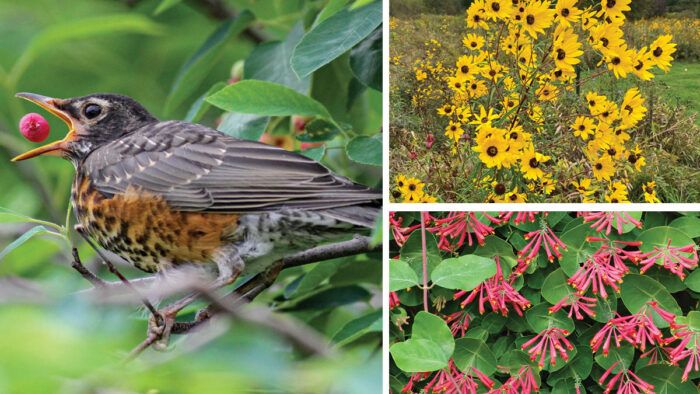
Gardeners love the creatures that inhabit their backyard worlds almost as much as they love their plants. And with the issue of climate change and loss of natural habitat now right at our doorstep, it has never been a more critical time to do what we can to support birds and pollinators in our cultivated landscapes. There are many plant options and steps we can take that will attract and nurture our winged friends in their search for food, water, nesting materials, and refuges in our gardens.
Choosing plants that can serve as food at various times of year, and for different stages of wildlife cycles, is a key ingredient to a bird- and pollinator-friendly garden. When making selections do not only consider attributes that you like, but choose qualities that are important to wildlife as food in the form of foliage for butterfly caterpillars, flowers for bees, and berries for birds.
Taking steps to provide water and manage pest and diseases in a way that will not harm innocent creatures or the environment is an important consideration too. The introduction of even the smallest water features, such as a bird bath or tabletop fountain, helps to support the creatures who visit our gardens. At the same time, applying nontoxic disease-control methods, such as growing disease-resistant varieties of plants, keeps all visitors in the garden safe. By working toward the goal of creating backyard habitats that benefit everyone, people and wildlife, we can establish outdoor spaces that are beautiful and that contribute to the sustainability of the natural environment and of the animals that depend on these spaces.
More information:
Pollinator declines and possible causes
Sustainable forage in the United States
-
 How-To
How-ToNative Plants for the Birds
The right native plant species can make your garden an avian haven. -
 How-To
How-ToInviting Birds Into Your Garden
Lure them in with food, shelter, and water. -
 Design
DesignHummingbird Favorites
Find out what all the buzz is about by planting these colorful perennials. -
 Design
DesignDesigning a Stylish Pollinator Garden
Careful plant placement helps this space attract a plethora of good insects without looking messy. -
 How-To
How-ToA Hole in Every Host Plant
Here are just a few of the host plants we grow within the garden, and the caterpillars they nourish. -
 Design
DesignHooked on Hyssops
Give these perennials the essentials, and they’ll reward you with flowers, fragrance, and hummingbirds. -
 Design
DesignThe Best of the Bee Balms
Trial results identify the most disease-resistant and pollinator-friendly varieties. -
 Garden Photo of the Day
Garden Photo of the DayCreating Homes for Pollinators
Palaces and plants make for happy pollinators. -
 Design
DesignTake a Walk on the Wild Side
Create a creature-friendly garden that’s in tune with nature and that looks good too. -
 How-To
How-ToPlants to Attract Wildlife
If you want to attract wildlife, then adding plants to your garden that can serve as food will help. -
 Design
DesignSimple Ways to Add Water to the Garden
Create harmony between water features and surrounding elements. -

-
 How-To
How-ToHow to Manage Pests Sustainably With IPM
These dos and don’ts show how this earth-friendly approach can be adapted to any size garden. -
 Kitchen Gardening
Kitchen GardeningAttract Beneficial Insects to Your Garden
Get acquainted with the good bugs and lure them to your garden by planting flowers they like. It's a green way to keep your vegetables healthy.
-
 Design
DesignBring the Buzzzzz Back to Your Garden
Enliven your beds with flowers that attract, nurture, and nourish bees












